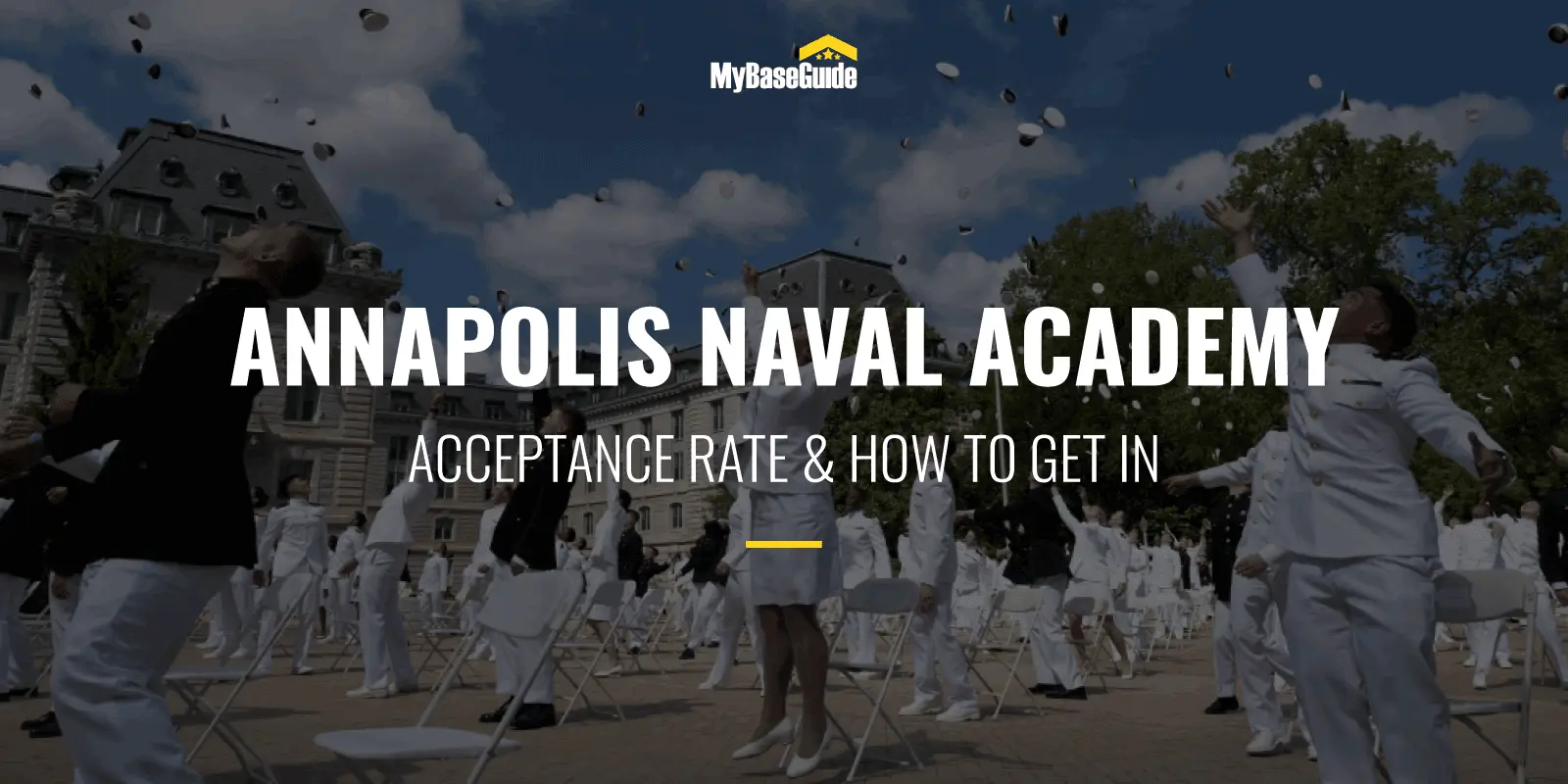ANNAPOLIS NAVAL ACADEMY ACCEPTANCE RATE & HOW TO GET IN

Introduction
One of the most highly recognized and academically acclaimed institutions of learning in the nation, the United States Naval Academy at Annapolis is a shining example of educational excellence. The Academy’s motto, Ex Scientia Tridens, (From Knowledge, Seapower), serves to highlight how the undergraduate college of our country’s naval service values intellect and the advantage it gives U.S. Sailors in missions around the globe. Being accepted to the Academy as a as fourth-class “plebe” and rising through the ranks to a Midshipman, First Class, is a journey that tens of thousands of students have navigated since 1845. Today, you could be sharing this incredibly challenging but rewarding experience with about 4,500 total Midshipmen and about 500 academic staff members. It would be a time in your life you’ll never forget, building skills, character and friendships that will serve you the rest of your life. But are you ready to even start preparing to enter the USNA? To meet the mission of morale, mental and physical development? To reach the ideals of duty, honor and loyalty? Let’s take an in-depth look at the Academy in all its glory and what your path to get there would typically look like. 1. Where is the Naval Academy? 2. Map of the Campus 3. Admissions ⚬ Entrance Requirements ⚬ Acceptance Rate 4. How to Take a Tour of the Academy 5. What it Takes to Be a Cadet ⚬ Typical Weekday Schedule ⚬ Uniforms ⚬ Ranks 6. Majors Offered 7. Sports Program 8. All About Graduation 9. Naval Academy History
Where is the Naval Academy?
History lives on today at the U.S. Naval Academy, which itself is a National Historic Landmark. The 338-acre campus occupies the former grounds of Fort Severn at the confluence of the Severn River and Chesapeake Bay in Maryland’s Anne Arundel County, 33 miles east of Washington, D.C.; and 26 miles southeast of Baltimore.United States Naval Academy
121 Blake Rd. Annapolis, MD 21402Phone:
1 (410) 293-1000Naval Academy Map
 Access to the Academy grounds has been limited (even before the COVID-19 pandemic), however, under regular conditions, anyone with a locally prepared USNA ID Card or a DOD credential, including military retirees and dependents, may drive onto the USNA. All others will need to park outside the Academy and walk in through Gate 1.
Download a map of The Yard; learn about security regulations and access updates; and get directions from Washington, D.C., and Baltimore and Annapolis, Maryland; at the USNA website.
Access to the Academy grounds has been limited (even before the COVID-19 pandemic), however, under regular conditions, anyone with a locally prepared USNA ID Card or a DOD credential, including military retirees and dependents, may drive onto the USNA. All others will need to park outside the Academy and walk in through Gate 1.
Download a map of The Yard; learn about security regulations and access updates; and get directions from Washington, D.C., and Baltimore and Annapolis, Maryland; at the USNA website.

Naval Academy Admissions
You may be wondering, “How hard is it to get into the Naval Academy?” We’re not going to lie: IT’S HARD. Hard, but well worth it. You’ll face intense admission standards, rigorous physical training and academic coursework designed to make your mind as fit and adaptable as your body. Not only will your four years at the Academy shape you into an inspiring leader, it will open a world of opportunities for you in your Navy career and beyond. Getting into the Academy is just the beginning of the challenges you’ll face and overcome. But one thing you won’t have to worry about while attending USNA is figuring out how to pay for it. The Navy pays 100% of the Naval Academy tuition, room and board, and medical and dental care costs of Naval Academy Midshipmen. All students who attend the Academy do so on a full scholarship in return for five years of active-duty service upon graduation. Think of it as 100% post-graduation employment. Midshipmen pay is $1,087.80 monthly, from which laundry, barber, cobbler, activities fees, yearbook and other service charges are deducted. Actual cash pay is $100 per month the first year, which increases each year thereafter.Naval Academy Requirements
You can’t just dip your toe in the water if you want to make it into the Naval Academy. In fact, preparing for admission is a process some take so seriously that many plan much of their academics and extra-curricular activities in their high school years to reflect strong academics and character. The following steps are listed by the Academy as the general requirements for any application, but going above and beyond these basics can set yourself up for a better chance at acceptance. OK, let’s dive in! (You do know how to swim, right? No really, add that to your list too.)1. Confirm Eligibility
To even begin to apply, you must meet the following criteria:- Be a United States Citizen by July 1 of the year of entry.
- Be at least 17 years old but not older than 23 on July 1 of the year of entry.
- Be unmarried.
- Be not pregnant and have no dependents.
- Have a valid Social Security Number.

2. Preliminary Application
You must submit a preliminary application to become an official candidate for next year's class. Submit this application if you:- Will be a senior in high school next year.
- Are currently in your senior year of high school.
- Are a current college student looking to transfer
- Social Security Number.
- High School Educational Testing Service (ETS) Code.
- High school class rank.
- Congressional state and district.
- Full ZIP code.
- SATT, ACT or PSAT scores.
3. Apply for Nomination
To get into the Academy, you must also receive a nomination from an official source, usually a U.S. Representative or U.S. Senator representing your Congressional district or state, and the Vice President of the United States. Being personally acquainted with the nominator is not necessary. You should submit your letter of application for nominations immediately after you complete your preliminary application. Don’t wait until you receive a nomination to begin your formal USNA application. Many nomination notifications do not go out until early- to mid-January, and the deadline for the USNA application is Jan. 31. Your nominator will notify the Academy of your nomination. Nomination Process and Reference Information:- Find your Senator and Representative:
- Nomination Applications:
4. College Entrance Exams
Candidates for the Academy must take the Scholastic Assessment Test (SAT) or the American College Test (ACT) prior to admission. Admissions will accept any ACT or SAT taken before Feb. 28, even if the results arrive after. It does not accept test scores from a test taken with accommodations. Test scores should be forwarded to the Naval Academy using the appropriate College Code Numbers:- SAT Code – 5809
- ACT Code – 1742
5. Transcript
Your high school counselor must mail an official transcript to USNA.Office of Admissions
52 King George St. Annapolis, MD 21402Phone:
1 (410) 293-10006. Medical Examination
The Naval Academy requires all candidates to undergo a thorough medical examination because the program is physically challenging. The Admissions Department will submit your name to the Department of Defense Medical Examination Review Board (DoDMERB), which will contact you about scheduling your medical examination. About a month after your physical exam is completed, you will receive (by mail) a status report of the DoDMERB findings. You may check on the status of your medical exam by referring to the DoDMERB website. If you have a disqualifying condition, you will be automatically considered for a waiver if/when you receive a Conditional Offer of Appointment.7. Candidate Fitness Assessment
This assessment evaluates coordination, strength, speed, agility and endurance. You should have no difficulty with the assessment if you are accustomed to regular physical activity. The test can be administered by a physical education teacher, a team coach, a current JROTC instructor, an active duty commissioned officer, or a Blue and Gold officer. It consists of:- A 1-mile run.
- A “shuttle” run.
- A kneeling basketball throw.
- Abdominal crunches.
- Push-ups.
- Pull-ups or a flexed-arm hang for women.
Suggested Read:
Are You Military Fit? Take These Military Fitness Tests to Find Out!8. Interview
An official interview with a Blue and Gold Officer is the last official step in completing your application. These officers are a group of volunteers composed of Naval Academy graduates, parents of midshipmen or graduates and civilians. All candidates should contact their Blue and Gold Officer immediately upon receipt of their official candidate letter. The preferred communication method for most Blue and Gold Officers is email. If you’re not sure who your assigned Blue and Gold Officer is, contact the Area Coordinator.9. Then You Wait
The USNA uses a “rolling admissions” selection process in which most candidates are notified of their final status by April 15. Appointees should notify the Admissions Office of their intention to accept or decline by May 1. On average, of the 3,000 students who qualify for the Naval Academy, 1,400 will receive appointments but only about 1,200 become Midshipmen. Setting high standards for yourself now as you undergo the application process will be a foundation for the high level of performance you will need in everyday life at the USNA. Find more details, including the portal login to begin your application process, on the USNA website here.Naval Academy Acceptance Rate
So you thrive on competition and pushing yourself physically and mentally to a higher standard? OUTSTANDING. You will need that personal drive just to get your foot in the door at the Academy. The USNA is the most competitive of the U.S. military service academies in terms of admissions, with only about nine of every 100 applicants being accepted, or about 8%.
The USNA is the most competitive of the U.S. military service academies in terms of admissions, with only about nine of every 100 applicants being accepted, or about 8%.

Naval Academy Tour
One of the best ways for prospective applicants to get a feel for life at the Academy is to walk a mile in their shoes during a certified tour of The Yard. Tours are led by professional guides who help bring the historic and present-day traditions of the Academy to life. Guided walking and driven tours for the public are available at the Armel-Leftwich Visitor Center, inside USNA Gate 1 near the Annapolis harbor at 52 King George St. Pedestrian entrances are on Prince George and Randall streets. The visitor center also has a variety of guided walking tours for private groups.Armel-Leftwich Visitor Center
52 King George St. Annapolis, MD 21402Phone:
1 (410) 293-8687Note:
Unfortunately, tours of the USNA grounds have been suspended during the Coronavirus pandemic, and the Visitor Center and gift shop are temporarily closed. Visit the Naval Academy Business Services Division webpage for more info about required ID for guest visits, United States Naval Academy Admissions briefings, access to the U.S. Naval Academy Museum and updates to when regular visits can resume under Centers for Disease Control guidelines.
Naval Academy Cadet
Midshipmen at the Academy come from all 50 states, U.S. territories and several countries. And while no two are ever alike, these special men and women all share a commitment to something larger than themselves. You’ll be expected to work harder than you probably ever have before to excel in this highly structured environment.Typical Daily Schedule
A typical weekday for a midshipman looks something like this:- 0530 — Arise for personal fitness workout (optional)
- 0630 — Reveille (all hands out of bed)
- 0630 to 0700 — Special instruction period for plebes
- 0700 — Morning meal formation
- 0715 — Morning meal
- 0755 to 1145 — Four class periods, 50 minutes each
- 1205 — Noon meal formation
- 1210 — Noon meal
- 1250 to 1320 — Company training time
- 1330 to 1530 — Fifth and sixth class periods
- 1545 to 1800 — Varsity and intramural athletics, extracurricular and personal activities; drill and parades twice weekly in the fall and spring
- 1830 to 1915 — Evening meal
- 2000 to 2300— Study period
- 0000 — Taps for all midshipmen. GET SOME SLEEP.
Naval Academy Cadet Uniforms
Midshipmen at the Academy wear service dress uniforms similar to those of U.S. Navy officers, with shoulder-board and/or sleeve insignia varying by school year or Midshipman officer rank. These uniforms ensure that a sharpness of appearance is maintained. Depending on the season, midshipmen wear Summer Whites or Service Dress Blues as their dress uniform and working blues as their daily class uniform. Leadership will advise which uniforms are required during all conceivable situations and events.More like this:
U.S. Military Dress Uniforms: What Each Branch Wears To Look Their BestNaval Academy Cadet Ranks
Midshipmen at the Academy are not classified as freshmen, sophomores, juniors or seniors like at a typical university. They advance each year as fourth-class, third-class, second-class and first-class Midshipmen, respectively. You’ll become quickly acquainted with the Academy’s hierarchy during “plebe summer” before academic classes begin. This period is designed to turn civilians into Midshipmen. On Induction Day, you’ll be put into uniform and taught how to salute by the first-class Midshipmen who lead the plebe indoctrination program. Insignia on uniforms specially designate the Midshipmen ranks and officers at the Academy. Don’t worry; you WILL learn to recognize the ranks and the appropriate responses. For now, find a highly detailed guide to uniform regulations, insignia and decorations, grooming standards and more at the USNA website.
Naval Academy Academics
At the Academy, academics primarily focus on science, technology, engineering and mathematics (STEM) to meet the highly technical demands of the Navy. While the majority of midshipmen may choose their majors freely, the needs of the Naval Service take precedence. Midshipmen at the Academy may choose to pursue the following majors:- Aerospace Engineering +
- Arabic
- Chemistry +
- Chinese
- Computer Engineering +
- Computer Science +
- Cyber Operations +
- Electrical Engineering +
- English *
- Foreign Area Studies
- General Engineering +
- General Science +
- History +
- Information Technology +
- Mathematics * +
- Mathematics with Economics +
- Mechanical Engineering +
- Naval Architecture & Marine Engineering * +
- Nuclear Engineering +
- Ocean Engineering * +
- Oceanography * +
- Operations Research +
- Physics +
- Political Science *
- Quantitative Economics * +
- Robotics and Control Engineering * +

Naval Academy Athletics
While every Midshipman is expected to make physical fitness a tested point of pride, athletic teams at the academy have gone beyond that to create some of the most successful and respected athletic traditions in the nation. The Academy’s intercollegiate sports program features 18 men’s teams, 12 women’s teams and three co-ed teams, plus an intramural and club sports program. All Midshipmen are required to participate in these programs, either at the varsity, intramural or club level. The following sports are represented at the USNA:Men’s Varsity
o Baseball o Basketball o Crew, heavyweight o Crew, lightweight o Cross Country o Football o Golf o Gymnastics o Lacrosse o Soccer o Sprint Football o Squash o Swimming and Diving o Tennis o Track, Indoor o Track, Outdoor o Water Polo o Wrestling
Women’s Varsity
o Basketball o Crew o Cross Country o Golf o Lacrosse o Intercollegiate Sailing o Soccer o Swimming and Diving o Tennis o Track, Indoor o Track, Outdoor o Volleyball
Co-ed Sports
o Rifle o Intercollegiate Sailing o Offshore Sailing
Club Sports
o Men’s
o
Women's
o
Co-Ed
Whether you suit up to compete against other NCAA Division I college athletes or if you line up for a friendly rugby scrum or if you find yourself yelling “FEAR THE GOAT!!!” at the top of your lungs from the stands at the Army/Navy football game, you’ll have a desire to win instilled in you from your first day. You almost can’t help it, especially when accompanied by the Naval Academy Marching Band playing “Anchors Aweigh.” You can click the link here to get to know Bill the Goat, the official mascot of USNA athletics, where it explains how he came to represent the academy, how many Bills have spurred teams on to success and which Bill was a frequent kidnap victim by rival schools. Learn more about USNA Varsity sports — including tickets, schedules, scores, the fan zone and more — at the official USNA Sports website.
Naval Academy Graduation
Upon completion of four years at Naval Academy, First Class Midshipmen are honored with their graduation during Commissioning Week. Parents, family members and guests may attend a series of events, including a Blue Angels flight demonstration, the Color Parade, special awards ceremonies and music performances. The week culminates in graduation ceremony, the oath of office, the conferral of diplomas and awarding of commissions to graduating Midshipmen. It’s also when you’ll likely experience one of the most famous traditions of the Academy: the Cover Toss. After graduates respond with a hearty “I DO!” to their oath of office, the new ensigns in the Navy or second lieutenants in the Marine Corps discard their now obsolete midshipman hats by tossing them into the air in a visually stunning celebration of their change of status.
Naval Academy History
According to the Academy’s Blue and Gold Book, here are some of the highlights from the USNA’s robust history.- Secretary of the Navy George Bancroft lays the foundation for the Naval Academy when, in 1845, he established the Naval School at Fort Severn in Annapolis, Maryland.
- In 1850, the Naval School became the United States Naval Academy. The next year, the Academy adopted its current course of instruction which includes four consecutive years at Annapolis, with at-sea training provided during summers.
- After moving to Newport, Rhode Island, during the Civil War, the Academy was re-established at Annapolis in 1865.
- During the late 19th century, immense changes in naval technology, including the conversion of sail-powered, wooden ships to steam-powered steel vessels, resulted in rapid developments in naval weaponry and tactics.
- By World War I, there were nearly 200 graduates each year, along with 2,500 reserve officers who received their training at the Academy.
- In 1930, the Association of American Universities accredited the Naval Academy, and in 1933, an act of Congress authorized the Naval Academy to confer the degree of bachelor of science on graduates, beginning with the Class of 1931.
- During World War II, summer sessions were instituted and the course was shortened to three years. As during the Great War, reserve officers, along with reserve midshipmen, also trained at the Academy.
- In 1949, Midshipman Wesley Brown became the Academy’s first African-American graduate.
- In 1963, the Academy initiated the Trident Scholar Program, under which a number of exceptional students are permitted to pursue independent research during the first class (senior) year.
- During the 1964-65 academic year, the number of required core courses was reduced and, for the first time, each midshipman was allowed to pursue academic areas of individual interest for minor or major.
- In 1975, President Gerald Ford signed legislation authorizing admission of women to the service academies. The first women midshipmen entered the Academy in July 1976, and in 1980, Elizabeth Anne Rowe became the first woman member of the class to graduate.
When Was the Naval Academy Founded?
Established on Oct. 10, 1845
, under Secretary of the Navy George Bancroft, the USNA is the second-oldest of the five U.S. service academies, with only West Point, the academy for the U.S. Army, being older.Famous Naval Academy Graduates
Throughout its history, the academy has forged the mettle of many a fine leader. Among its graduates, the academy claims one U.S. president, three U.S. Cabinet members, 26 members of Congress, five Secretaries of the Navy, five Chairmen of the Joint Chiefs of Staff, two Nobel Prize winners, 54 astronauts and countless more outstanding individuals. Check out the USNA website for more details and profiles of some of the most famous graduates, including:- Jimmy Carter
- Maj. Gen. Charles Bolden
- Wendy Lawrence
- John McCain
- Fleet Adm. Chester W. Nimitz
- H. Ross Perot
- David Robinson
- Alan Shepard
- Roger Staubach
- Vice Adm. James B. Stockdale
Conclusion
The United States Naval Academy serves as a beacon to students seeking a world-class education and rewarding military commission. When you join The Brigade, you’re not just joining the student body of one of the world's best academic institutions, you’re contributing to the historic tradition that has kept the fleet physically strong and mentally nimble for hundreds of years. We hope you’ve found this overview both illuminating and entertaining. Still thirsty for more details on how to prepare and what to expect at the Yard? Download a PDF of the Academy’s Blue and Gold book online for additional guidance.The appearance of U.S. Department of Defense (DoD) visual information does not imply or constitute DoD endorsement.
SHARE:
TAGS:
JOIN OUR NEWSLETTER
Get the latest news and military discounts




